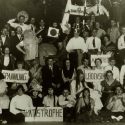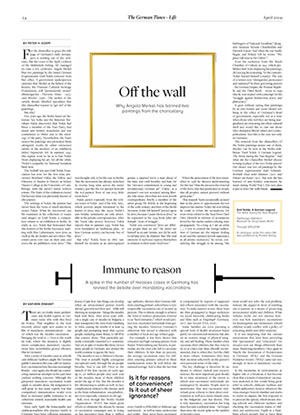Why Angela Merkel has banned two paintings from the chancellery
For the chancellor to grace the title page of Germany’s daily newspapers is nothing out of the ordinary. But the cover of the April 5 edition of the Süddeutsche Zeitung (SZ) managed to raise a few eyebrows: Angela Merkel has two paintings by the famed German Expressionist Emil Nolde removed from her office. A government spokesperson asserted that Merkel, at the behest of the lender, the Prussian Cultural Heritage Foundation, will “permanently return” Blumengarten (Thersens Haus) (1915) and Brecher (1936). The author of the article, Renate Meinhof, speculates that the chancellor wanted to “get rid” of the paintings.
But why?
Five years ago, the Berlin-based art historian Aya Soika and the historian Bernhard Fulda discovered that Nolde had been a member of the Nazi Party, had made anti-Semitic statements and was committed to Hitler and to the ideology of the party. Nevertheless, the Nazis seized his paintings and presented them alongside works by other ostracized artists in the mockery of an exhibition titled Degenerate Art. In summer 1941, the regime went so far as to ban Nolde from displaying his art. Yet all the while, Nolde’s sympathy for National Socialism held firm.
The Seebuell Ada und Emil Nolde Foundation has now, for the first time, presented Bernhard Fulda, the Fellow and Director of Studies in History at Sidney Sussex College at the University of Cambridge, with the artist’s entire written estate. The fruits of the evaluation extend far beyond what was previously known of the painter.
The writings of Nolde, the painter, had never been the focus of much attention, notes Fulda. What he discovered can be examined in his collection of essays and images on Emil Nolde, a companion volume to an exhibition in Berlin. As early as 1911, Nolde had bemoaned that the leaders of the Berlin Secession, starting with Max Liebermann, were Jews, as well as the art dealers and art critics: “the entire press core was on their side, and even the art publishers were Jews.” This was thought only to be the case in Berlin, “but the movement has already stretched its wormy long arms across the entire country, just like the rot spreads beneath the red-painted floor of our cozy little room here.”
Fulda quotes copiously from the written notes of Nolde (and of his wife, Ada), which provide ample testament to his hatred of Jews. Into the 1930s, Nolde’s anti-Semitic sentiments are only detectable in his private correspondence. After the Nazis take power, however, Fulda reports that in summer 1933, Nolde has even formulated an “ambitious plan… of how German society can become free of Jews.”
But why? Nolde, born in 1867, saw himself for decades as an unrecognized genius, a spurned lover, a man ahead of his time, met with hostility and hate for his “devoted commitment to young and revolutionary German art” (Fulda), as a peasant’s son not accepted among liberals, who more often than not were Jewish cosmopolitans. Briefly a member of the artist group Die Brücke at the beginning of the 20th century, and then of the Berlin Secession, Nolde felt himself “preyed upon by Jews, because I paint them as Jews,” as he expressed in his 1934 book Jahre der
Kämpfe (Years of struggle).
Nolde was convinced: “Jews are different people than we are.” He didn’t see himself as an anti-Semite, nor did he seek to defame Jews, he claimed. But “the vital interests of each race express themselves in relation to their inner vital force.”
When the persecution of the Jews intensified in 1938, he showed understanding for the fact “that the process the removal of the Jews, who had penetrated so deeply into all peoples, cannot proceed without great pain.”
That staunch Nazis occasionally accused him in the press of opportunism did not improve the matter. Nolde did everything he could to refute the accusations. He even wrote a letter to the Nazi Press Chief Otto Dietrich in defense of accusations levied by the media outlets echoing state propaganda: “As a long as I am an artist […], I vow to contest the foreign infiltration of German art, the impure dealing in art and the outsized Jewish supremacy in all artistic endeavors,” he wrote, considering this struggle to be among “the harbingers of National Socialism,” alongside Houston Stewart Chamberlain and Dietrich Eckart. And when the war finally began, and Poland fell, he wrote: “We place full trust in Der Führer.”
Even his exclusion from the Reich Chamber of Culture in 1941, which prohibited him from displaying his paintings, did not jog his reasoning. To the contrary, Nolde fancied himself a martyr. The son of a farmer, now “disregarded, persecuted and outlawed” by three governing powers – the German Empire, the Weimar Republic and the Third Reich – wrote in 1943 that he was treated with contempt for his “struggle against Bolshevism, Jewry and plutocracy.”
It goes without saying that paintings by an anti-Semite and racist should not hang in the office of Germany’s head of government, especially not at a time when those who feel they are being marginalized are retreating into their cultural shell and would like to cast out those who champion liberal values and cosmopolitanism. And this is the case not only in Germany.
The removal from the chancellery of the Nolde paintings means one of them, Brecher, can be seen in the Berlin exhibition “Emil Nolde. A German Legend. The Artist during the Nazi Regime.” And what did the Chancellor Merkel choose to hang in place of the two Nolde pieces? Her choice was two oil paintings by the German expressionist Karl Schmidt-Rottluff: Haus unter Bäumen (1910) and Häuser am Kanal (1912). But now she has learned of anti-Semitic statements he made during World War I. Her new plan is just to leave the walls blank.
Emil Nolde. A German Legend. The Artist during the Nazi Regime
Hamburger Bahnhof Museum für Gegenwart, Berlin Through 9/15/2019 A catalogue under the same title was published by Prestel Verlag.
Peter H. Koepf
is editor in chief of The German Times. Together with Franziska Schreiber he wrote the best-selling book Inside AfD. A Report by One Who Left, which was published in German in August.




